| home > 2009 financial > consolidated > financial review |
home > 2009 financial > consolidated > financial review
Review of Balance Sheet, Income Statement and Financial situation
Income Statement
The Rai Group income statement for 2009 shows a net loss of 61.8 million euros, against a loss of 7.1 million euros for
2008. The difference with the result of the Parent Company result, which presents a net loss of 79.9 million euros, is largely
determined by the elimination of the dividends disbursed by the Group companies in relation to the previous year's results
against those for the year ending.
The following section provides an overview of the main items of the Income Statement and the reasons behind the more significant
The following section provides an overview of the main items of the Income Statement and the reasons behind the more significant changes from the previous year.
Revenues from sales and services
Revenues from sales and services consist of licence fees, advertising revenues and other commercial revenues. They totalled 3,177.8 million euros, down 33.1 million euros (-1.0%) on 2008.

A breakdown of revenues from sales and services, per company and net of operations between Group companies, is presented in the following table.
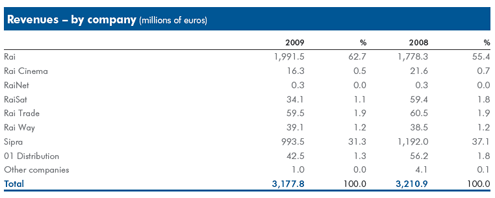
Licence fees (1,645.4 million euros). These include licence fees for the current year as well as those for previous years, collected through coercive payment following legal registration, as highlighted in the following table.

The increase (+1.6%) is mainly attributable to an increase in the per-unit licence fee from 106.00 Euros to 107.50 euros
(+1.4%), with the remainder accounted for by an increase in the number of paying subscribers.
Advertising revenues (988.5 million euros) show a drop of 199.2 million euros (-16.8%) on 2008. The drop in advertising
revenues was largely determined by the serious international financial recession which characterised the closing months of
2008 and the whole of 2009 and implicated significant declines in the international and domestic economies, resulting in a
sharp reduction in investments in advertising. This was further accentuated by the absence of important sports events in 2009,
which had characterised the previous year.
The reference market (TV, Radio, Cinema and Internet) showed an overall decline of about 8.5% (source Nielsen) in 2009.

Other revenues (543.9 million euros) show a decline of 139.9 million euros (+34.6%). This was mainly determined by the
by the Parent Company sale to third-parties during the year of the pay TV rights to broadcast the 2010 and 2014 World Cup
football matches and other minor FIFA events, for 175 million euros.
Other opposing factors, of little significance when considered separately, are highlighted in the table below. Negative items include
the Sale of rights, musical publications and theme-based satellite channels item, the effects of the failure to renew the agreement
for the supply of channels to Sky and the reduction in the Film and home video distribution and Telephone services items. Positive
items include Sale of rights to utilise archive materials and the effects of the agreement entered into with a leading football club.
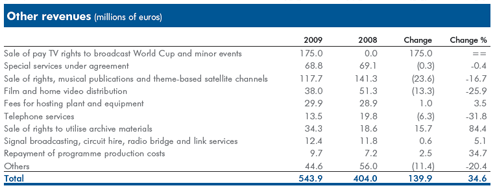
A breakdown of other revenues, per company and net of operations between Group companies, is presented in the following
table.
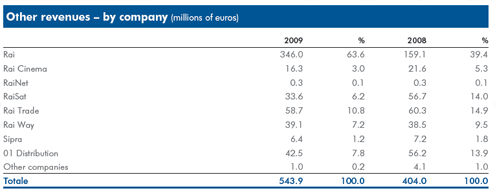
As shown in the following table, the relative weights of the three components in total revenues from sales and services show an increase in the Licence Fees and Other revenues items compared with the totals for the previous year, to the detriment of the Advertising component.
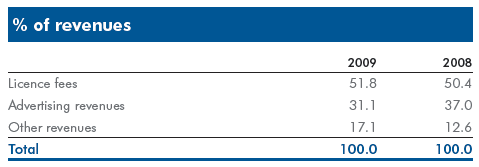
Operating Costs
These total 2,540.2 million euros, falling 30.5 million euros compared with 2008, equating to 1.2%, the reasons for which
are listed below.
The item includes internal costs (labour cost) and external costs, regarding ordinary business activities, classified as follows.
Cost of goods and external services – This caption includes purchases of goods and services required to make programmes
of immediate-use (purchases of consumables, external services, artistic collaborations, etc), filming rights for sports events,
copyright, running costs (rental and hire fees, telephone and postage, cleaning, maintenance, etc.) and other operating costs
(direct and indirect taxes, contribution to the Authority, the public broadcasting concession fee, etc.).
As shown in the table, the caption shows a drop of 30.5 million euros (-2.0%) from contrasting phenomena. In detail, there
was an increase of 169.3 million euros determined by the cost of pay TV rights to broadcast the 2010 and 2104 World Cup
football matches and minor FIFA events subject to the aforementioned sale to third parties.
Net of this component, the item amounts to 1,361.3 million euros, with a drop of 199.8 million euros, mostly deriving from
the reduction in costs for the purchase of filming rights, mainly relating to the broadcasting rights for sports event and the
Sanremo Song Festival (-143.3 million euros). As in all odd numbered years, 2009 was characterised by the absence of important
four-yearly sports events (European Football Championships and the Olympic Games) which had influenced the 2008
income statement by 164.6 million euros.

A breakdown by individual Group company of the cost of goods and services, net of transactions between Group companies, is given in the following table:
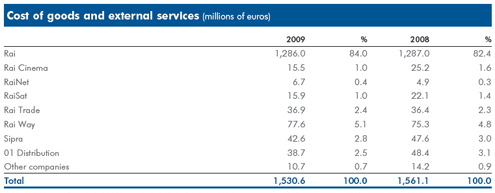
Personnel costs. These amount to 1,009.6 million euros, unchanged from the total at 31 December 2008, as detailed in the table below.

The previous year's trend of personnel cost containment was confirmed, remaining well below the rate of inflation.
This result is the product of various operational interventions. Firstly, the positive effects of resignation incentives in 2008 and
the new 2009 incentives made it possible to considerably counteract the economic impact of the assignment of permanent
employment contracts to temporary workers and to significantly limit physiological growth in labour costs deriving from contract
renewals, meritocratic policies and increases for length of service.
In addition to policies regarding resignation incentives, interventions on all the variable captions (overtime, rises and payment policies) weighed positively on the containment of labour costs, as did the lowering of the severance pay fund revaluation index.
A breakdown of personnel costs by individual Group company is given in the following table.
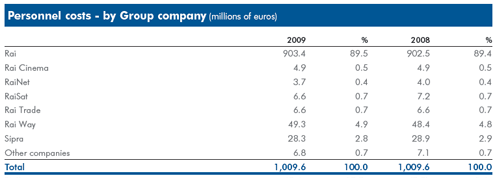
Personnel on payroll at 31 December 2009 (including 56 work-introduction and apprenticeship contracts) amounted to 11,387, up 78 on the same date of the previous year. In detail, Group company leavers numbered 299, of whom 121 left under resignation incentives, while engagements numbered 377, 289 of which following the signing of permanent employment contracts by temporary workers in application of trade union agreements, 29 returns to work following legal action and 4 compulsory placements.
The average number of employees, including those on fixed-term contracts, came to 13,352, up 116 from the previous year due to an increase of 75 in the number of staff on permanent contracts and of 41 in the number of staff on fixed-term contracts.
Gross Operating Margin
The Gross Operating Margin, as a consequence of the above, is positive by 667.8 million euros, falling 5.2 million euros, or 0.8, on the previous year.
Amortisation of programmes
This caption is related to investment in programmes, which during 2009 amounted to 543.0 million euros, down 44.2 million euros (-7.5%), mainly due to TV fiction series which halted the growth trend shown in previous years.

A breakdown of investments in programmes by each individual company is shown in the following table:

Amortisation charged to the above captions for the year, 528.4 million euros, shows an increase of 8.3 million euros (+1.6%) compared with the previous year. This albeit modest growth is due to the positive influence during the year of the higher investments made in past years.

Other amortisation and depreciation
The 2009 movement in this caption, shown in the following table, is related to investments in tangible assets and to other investments and presents a total increase of 25.5 million euros (+20.0%) determined mainly by growth in investment in tangible assets (+19.4 million euros) made principally by Rai Way for the development of the digital terrestrial broadcasting service.

The table below shows the breakdown by company and type:

Amortisation/depreciation charged for the year amounts to 122.6 million euros, with a drop of 7.8 million Euros
compared with 2008, referring entirely to tangible fixed assets, in relation to the progressive completion of the depreciation
of assets acquired in the past.

Other net income (expense)
The caption, amounting to 52.3 million euros (against 12.0 million euros of net income in the previous year), comprises costs/
revenues not directly related to the Company's core business. In detail, the item comprises expenses relating to repeat-usage
programmes which it is not expected will be used, repeated or commercially exploited (36.4 million euros), provisions for risks
and charges (26.9 million euros), provision to the bad debt provision, (13.5 million euros), provision to the supplementary
pension fund for former employees (9.7 million euros), partly offset by net prior-year income (35.1 million euros).
The negative balance compared to 2008 (-64.3 million euros) is mostly related to the absence of the net prior-year income generated in 2008 by the results of a transaction agreement regarding copyright.
Operating result
The results described above for operating revenues and costs led to a deterioration in the operating result, from 34.5 million
euros in the previous year to -35.5 million euros this year, with a drop of 70.0 million euros.
Net financial expense
Net financial expense shows a loss of 4.8 million euros, improving on 2008 (-7.9 million euros). The item shows the economic effects of typical financial operations and comprises bank interest expense and income as well as that relating to Group companies and net income/expense in relation to exchange rates.

Financial operations show a drop in net interest payable to banks of 1.2 million euros, due to the rise in financial exposure to
third parties, partly offset by the drop in market rates.
Exchange rate differences, deriving from the purchase of sports broadcasting rights (Rai) and investments in intangible assets
(Rai Cinema) in US dollars, have been reduced considerably, partly thanks to hedges implemented in prior years, which limited,
at least to some extent, the marked oscillations in the exchange rate during the year.
The average cost of loans by banks and other lenders, consisting of current account credit lines, "hot cash" and stand-by
loans, has fallen considerably due to the significant reduction in the money market reference rates, to 2.3%.
Net exceptional income (charges)
The item, which highlights net exceptional income for 0.1 million euros (net exceptional charges of 0.3 million euros in 2008),
was generated by charges (6.8 million euros) for resignation incentives connected to the 2008-2010 three-year plan in excess
of the fund set up in 2007. It was partly offset by income linked to the amount receivable for the reimbursement of IRES following
the introduction of law which made the IRAP paid between 2004 and 2007 (5.0 million euros) partly deductible, and
to tax credit for research ad development expenses sustained in 2008 (0.6 million euros).
Income taxes
These amount to 22.1 million euros and represent the balance between current and deferred taxes as shown in the table.
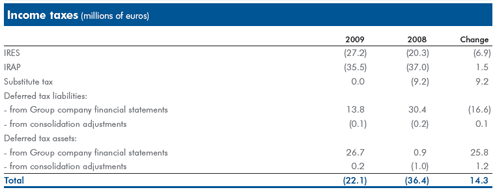
IRES of 27.2 million euros presents an increase of 6.9 million euros on the previous year's figure, relating to the better economic results of certain Group companies.
No amount was recorded for IRES for the Parent Company, as the year is expected to have a negative tax result.
IRAP for 35.5 million euros shows a drop of 1.5 million euros compared with the previous year, determined by the deterioration
of the taxable base related largely to the Parent Company.
Substitute tax, which amounted to 9.2 million euros in 2008, was related to the adhesion by certain Group companies to the
option for the realignment of the statutory/fiscal values envisaged by article 1, paragraph 48 of Law 244/07 (Budget 2008)
with the consequent release in 2008 of the previous provisions for deferred taxes for 19.9 million euros.
Deferred tax liabilities in 2009 determined a positive effect equating to 13.8 million euros (30.4 million euros in 2008), as a
consequence of the recovery of timing differences in income deriving from higher amortisation carried out during 2007 by the
Parent Company, purely for tax purposes.
Deferred tax assets (26.7 million euros) originated from the booking of IRES credit for 27.0 million euros, deriving from the
negative taxable amount for the year, which was related mainly to the Parent Company. This was offset by the positive tax
results of the subsidiaries, included within the scope of the tax consolidation mechanism for the 2009 tax year.
CONSOLIDATED BALANCE SHEET AGGREGATES
Non-current assets

Tangible assets amount to 581.2 million euros and are represented by land and industrial buildings for 30.8% and by plant and machinery for 37.2%.

The increase of 26.1 million euros with respect to 2008 is the balance of new investment (138.1 million euros), eliminations
(0.8 million euros) and depreciation (111.2 million euros).
Programmes are represented mainly by TV fiction series (495.3 million euros) and films (371.0 million euros). TV fiction series
accounted for the greater part of investment during the year (333.5 million euros).
The change from the previous year (-24.1 million euros) is the net result of the following factors:
• investment 543.0 million euros;
• depreciation for 528.4 million euros;
• writedown of programmes for 36.4 million euros;
• disposals for 2.3 million euros.

Equity investments amount to 13.3 million euros and present an increase on the previous year (+1.8 million euros), largely
due to the carriage of investments in associated companies and subsidiaries at equity (Sacis).
Other Non-current assets are shown in the following table:

Working capital
The change from 2008 (+91.5 million euros) is due mainly to normal developments in the business.

Major changes relate to:
• Trade receivables:, up 185.6 million euros, mainly determined by the booking of the receivables relating to the aforementioned
sale of the pay TV rights (115.5 million euros) and major receivables for services under agreement rendered
to the Government (72.8 million euros).
• Trade payables, up by 86.9 million euros and largely related to the booking of the cost of pay TV rights sold but for which
payment has still not been collected (87.0 million euros).
• Provisions for risks and charges, showed a 31.9 million euro reduction, mainly owing to the utilisations/releases of
provisions made during prior years, net of provisions made during the year.
Net financial position
The year-end net financial position is negative and has deteriorated compared to the previous year (-151.5 million euros
compared with +21.1 million euros in 2008), and is comprised as follows:

The undertaking of short-term debt is consequential to the reduction in advertising income, flows of commercial activity from the associated companies and liquidation of receivables for services under agreements rendered to the Government.
These effects were partly counteracted by income for the aforementioned sale of pay TV broadcasting rights and by the containment
of disbursements for important sports events and the operating expenses of the Parent Company and associated
companies.
The net financial position is negative for about 144 million euros, down from the previous year (-42 million euros), as a consequence
of the financial profile described above.
The analysis carried out on the basis of the financial and income structure indexes highlighted that:
• the net invested capital coverage ratio, calculated as in the ratio between net invested capital and net equity, is 1.24
(0.97 in 2008);
• the current ratio, identified as the ratio between current assets (inventories, current assets, cash and cash equivalents and
financial receivables) and current liabilities (current liabilities and financial debts) is 0.83 (0.90 in 2008);
• the self-coverage ratio of fixed assets, calculated as the ratio of shareholders' equity to non-current assets, is 0.39 (0.43
in 2008).
The financial risks to which the Group is exposed are monitored using appropriate computerised and statistical instruments. A policy regulates financial management in accordance with best international practice, the aim being to preserve the corporate value by taking an adverse attitude towards risk, pursued via active monitoring of the exposure and the centralised implementation of suitable hedging strategies by the Parent Company, also acting on behalf of the subsidiaries.
In detail:
• The exchange risk is significant in relation to the exposure in US dollars generated by the acquisition of rights to sports
events in foreign currencies by Rai (as well as the funding of the foreign associated company Rai Corporation) and of film
and television broadcasting rights by Rai Cinema. These commitments generated payments for about 170 million dollars
during 2009. Operation takes place from the date of subscription to the commercial commitment, often lasting several
years, and aims to defend the counter value in euros of commitments estimated at the time of order or in the budget.
Hedging strategies are implemented using financial derivative instruments � such as forward purchases, swaps, and options
structures � without ever taking on an attitude of financial speculation. The Group policy envisages numerous operating
limits to be observed by the hedging activity.
• The rate risk is also regulated by the company policy, particularly for medium/long-term exposure with specific operating
limits. At the moment, the financial position does not contain significant long-term and variable rate exposures, but sees
short periods of operational liquidity alternating with overdraft positions through reversible credit lines or stand-by loans,
for it was deemed unnecessary to activate hedging operations.
• The credit risk on cash deployment is extremely limited in that the company policy envisages the use of low-risk financial
instruments with parties with high ratings, for limited periods of cash timing differences. Only tied deposits or sight deposits
with remunerations close to the Euribor rate were used during 2009.
• As regards the liquidity risk, it should be noted that the Group has short-term credit lines with the banking system, which
are in excess of 500 million euros. During February 2009, the Parent Company took out a stand-by loan for 200 million
euros with a duration of three years, with a pool of seven Italian and international banks. The total loans are sufficient to
cover the overdraft positions that occur, although the procedure to liquidate the four deferred instalments by the Ministry
of the Economy and Finance could generate tension in the event of significant delays with respect to the quarter-end dates
established by contract. To cope with the significant investments required by the DTT project (particularly considering the
reduction in public funding), the company applied to the European Investment Bank for a medium/long-term loan, by
virtue of the innovative nature and general interest of the new infrastructure.
 |
 |